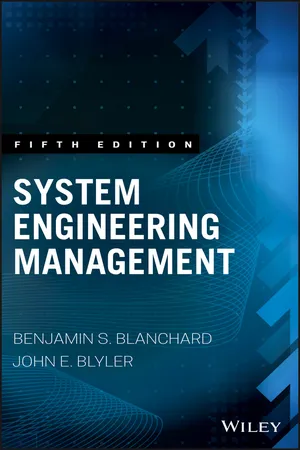Technology & Engineering
Engineering Organisations
Engineering organizations are groups of professionals who work together to design, develop, and implement engineering projects. These organizations can be found in a variety of industries, including construction, manufacturing, and technology. They typically have a hierarchical structure and are focused on achieving specific goals related to their field.
Written by Perlego with AI-assistance
Related key terms
Related key terms
1 of 4
Related key terms
1 of 3
4 Key excerpts on "Engineering Organisations"
- eBook - ePub
- Benjamin S. Blanchard, John E. Blyler(Authors)
- 2016(Publication Date)
- Wiley(Publisher)
Chapter 7 Organization for System Engineering The initial planning for system engineering commences during the early stages of conceptual design and evolves through the development of the System Engineering Management Plan (SEMP) described in Chapter 6. To implement this plan successfully requires an organizational structure that will promote, support, and generally enhance the application of system engineering principles and concepts. The proper organizational environment must be created that will allow for the accomplishment of system engineering requirements in an effective and efficient manner—that is, the implementation of a top-down, life-cycle-oriented, integrated approach in system design and development. In addition, the organization must be dynamic in response to the many changes that are taking place worldwide. Figure 6.1 (Chapter 6) shows two sides of the spectrum: the technology issues that can be applied to enhance and facilitate the implementation of the system engineering process and the management issues that are necessary to meet the objectives in this area. Inherent in this overall spectrum is the organizational element. Organization is the combining of resources in such a manner as to fulfill a certain need. Organizations constitute groups of individuals of varying levels of expertise, combined in a social structure of some form to accomplish one or more functions. Organizational structures vary with the functions to be performed, and the results will depend on the established goals and objectives, the resources available, the communications and working relationships between the individual participants, the motivation of personnel, and many other factors - eBook - ePub
Engineering Management
Meeting the Global Challenges, Second Edition
- C. M. Chang(Author)
- 2016(Publication Date)
- CRC Press(Publisher)
Engineering managers should be aware that informal organizations encourage additional bonding between employees. Because they contribute toward the smooth operation of an organization and members’ job satisfaction, employee participation in informal organizations are generally encouraged.3.11 ConclusionOrganizing is an important function of engineering management with a direct impact on the manager’s ability to get work done efficiently. This function empowers a manager to choose the right organizational forms, be they teams, committees, task forces, functional or matrix arrangements, or other specific organizational structures. Managers assign appropriately skilled and compatible people to work together, each one having clearly defined roles and responsibilities, along with commensurate authority. Managers assign responsibilities to employees so that work gets done and employees can receive broadened experience. Managers allocate the right resources (such as skills, money, equipment, time, and technology) to accomplish the work efficiently.Organizing is also important for enhancing the quality of work output. Flexible organizational structures allow companies to better respond to the changes of a dynamic marketplace. Certain organizational forms are superior to others in fostering creativity and inducing innovations. Multifunctional teams are known to be superior in handling conflicts at the interface between design and manufacturing or between R&D and marketing. Teams empowered by management to pursue specific assignments tend to be strongly motivating to the team members.Engineering managers need to understand the power of organizing and use the function intelligently. QUESTIONS1. What type of organizational structure is best suited for developing a new product that requires a high level of specialization in several functions and for which the time to market represents a critical factor?2. A materials manager suspects that the quality of work within her department has been deteriorating. She wants to introduce a program of change to advance quality. What steps should she take? - eBook - ePub
Mechanical Engineers' Handbook, Volume 3
Manufacturing and Management
- Myer Kutz, Myer Kutz(Authors)
- 2015(Publication Date)
- Wiley(Publisher)
External Business Environment. All five previously discussed enterprise subsystems operate within a socially, politically, and economically complex business environment. Especially for engineering and technology-intensive organizations, this environment is fast changing regarding market structure, suppliers, and regulations. Short product life cycles, intense global competition, low brand loyalty, low barriers to entry, and strong dependency on other technologies and support system are very common. These complexities call for specialized work processes, new concepts of technology transfer, and more sophisticated management skills and leadership.Managerial Impact. The need for speed, agility, and efficiency has an impact on the work process design, supply chain, organizational structure, management methods, tools, and techniques. It also affects business strategy37 and competitive behavior,38, 39 which often leads to collaboration and resource sharing via alliances, mergers, acquisitions, consortia, and joint ventures.Engineering managers often describe their organizational environments as “unorthodox,” with ambiguous authority and responsibility relations. They argue that such environments require broader management skill sets and more sophisticated leadership than traditional business situations. In this more open, dynamic business environment, enterprise performance is based to a large degree on teamwork. Yet, attention to individuals, their competence, accountability, commitment, and sense for self-direction are crucial for organizations to function effectively. Such a “team-centered” management style is based on the thorough understanding of the motivational forces and their interaction with the enterprise environment.3 Motivation and Engineering Performance
Understanding people, their wants and needs, is important in any management situation. It is especially critical in today's technology-based engineering organizations. Leaders who succeed within these often unstructured environments must work with cross-functional groups and gain services from personnel not reporting directly to them. They have to deal with line departments, staff groups, team members, clients, and senior management, each having different cultures, interests, expectations, and charters. Transforming these task multidisciplinary groups into cohesive teams is difficult. To get results, these engineering managers must relate socially as well as technically and understand the culture and value system of the organization in which they work. The days of the manager who gets by with only technical expertise or pure administrative skills are gone. - Graeme Martin(Author)
- 2016(Publication Date)
- Routledge(Publisher)
According to John Child (2015), one of the best-known organizational theorists, the most fundamental task of senior managers is to set the strategy of the organization and design the organizational structures, systems, culture and processes to deliver the strategy. While even the best organization in the world cannot make up for an unsound strategy, ‘superior organization offers one of the best sustainable sources of competitive advantage’ (Child, 2015, p. 4). Designing organizations and managing in the organizational context refers to the tasks of understanding, analysing and designing structures, systems and processes to coordinate and motivate large numbers of people undertaking interconnected activities, often in different locations (Roberts, 2004). At this level, managers have to take more macro-level decisions than those affecting only individuals and teams. These decisions can have significant consequences for the strategic aims of the organization, because it is through organizational structure that strategy becomes realized. Consequently, it is extremely important that you understand some of the basic design principles of organization and the potential advantages and drawbacks of adopting different organizational forms, including some of the newly emerging ones that have captured the imagination of the business press. So, in this chapter we shall attempt to address the practical problems of organizational design, first by examining a case study and, second, by introducing you to some concepts and models that will help you understand the problems faced by senior managers in designing organizations and the solutions available to them.You should read the case study of Innovative Petroleum Engineering, a pseudonym for an oil services company we shall use throughout this chapter to help you understand and apply key concepts. Your ability to understand some of the choices that managers face in designing organizations, analyse the problems faced by the case company and your choice of design solutions should improve as you work your way through the chapter. We shall also look at cases of newer forms of organization that are becoming more popular in certain contexts and industries, especially those connected with knowledge-intensive, technologically based and creative organizations, which are discussed in Chapters 7 , 8 and 9 of this book.CASE 4.1 INNOVATIVE PETROLEUM ENGINEERING – AN INTEGRATIVE CASE STUDY
Innovative Petroleum Engineering is the pseudonym of a major subsidiary of a US multinational operating in Europe. It produces sophisticated drilling equipment, which is used by other major firms in the Oil and Gas industry. Its parent company is a well-known Fortune
Index pages curate the most relevant extracts from our library of academic textbooks. They’ve been created using an in-house natural language model (NLM), each adding context and meaning to key research topics.
Explore more topic indexes
Explore more topic indexes
1 of 6
Explore more topic indexes
1 of 4



